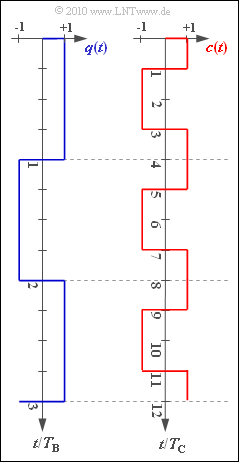Exercise 4.5Z: About Spread Spectrum with UMTS
With UMTS/CDMA, the so-called "Pseudo-noise modulation" is applied. Or: "Direct Sequence Spread Spectrum":
- The rectangular digital signal $q(t)$ is thereby multiplied by the spreading signal $c(t)$ to give the transmitted signal $s(t)$.
- This is higher in frequency than $q(t)$ by the spreading factor $J$, and is referred to as "spread spectrum".
- At the receiver, the same spreading signal $c(t)$ is multiplied in phase synchronism, reversing the spreading process ⇒ "despreading".
The graph shows example signal waveforms for $q(t)$ and $c(t)$.
In the subtask (5) is asked about transmit chips. For example, the "transmit chip" $s_{3}$ denotes the constant signal value of $s(t)$ in the time interval $2 T_{\rm C} ... 3 T_{\rm C}$.
Hints:
- This exercise mostly refers to the page "Telecommunications Aspects of UMTS".
- For calculation of chip duration $T_{\rm C}$ reference is made to the theory page "Physical channels" in the chapter "UMTS network architecture".
- There you will find, among other things, the information that on the so-called Dedicated Physical Channel ('DPCH ) in ten milliseconds exactly $15 \cdot 2560$ chips are transmitted.
Questions
Solution
(1) Correct is the answer 2:
- Fixed for UMTS is the chip duration $T_{\rm C}$, which is still to be calculated in the subtask (2).
- The larger the spreading degree $J$ is, the larger the bit duration is.
(2) According to the note on the information page, exactly $15 \cdot 2560 = 38400$ chips are transferred in ten milliseconds.
- Thus the chip rate $R_{\rm C} = 100 \cdot 38400 \ {\rm chips/s} \hspace{0.15cm}\underline{= 3.84 \ \rm Mchip/s}$.
- The chip duration is the reciprocal of this: $T_{\rm C} \hspace{0.15cm}\underline{\approx 0.26 \ \rm µ s}$.
(3) Each data bit consists of four spreading chips ⇒ $\underline{J = 4}$.
(4) The bit rate is given by $J = 4$ to $R_{\rm B} \hspace{0.15cm}\underline{= 960 \ \rm kbit/s}$.
- With the maximum spreading factor for UMTS $J = 512 $, on the other hand, the bit rate is only more $7.5 \ \rm kbit/s$.
(5) For the transmitted signal $s(t) = q(t) \cdot c(t)$.
- The chips $s_{3}$ and $s_{4}$ of the transmitted signal belong to the first data bit $(q_{1} = +1)$:
- $$s_3 = c_3 \hspace{0.15cm}\underline {= -1},\hspace{0.4cm}s_4 = c_4 \hspace{0.15cm}\underline {= +1}\hspace{0.05cm}.$$
- In contrast, the two other transmitting chips we are looking for are associated with the second data bit $(q_{2} = -1)$ :
- $$s_5 = -c_5= -c_1 \hspace{0.15cm}\underline {= -1},\hspace{0.4cm}s_6 = -c_6= -c_2 \hspace{0.15cm}\underline {= +1}\hspace{0.05cm}.$$
